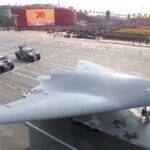Raytheon and Anduril Industries have conducted a successful test of a high-loaded grain (HLG) solid rocket motor designed to power future air-to-air missiles. The test marks a key milestone in propulsion modernization efforts that could enable longer-range and higher-speed interceptors for U.S. and allied air forces.
Breakthrough in Solid Propellant Design
The HLG solid rocket motor test was carried out in partnership with the U.S. Navy’s Naval Air Warfare Center Weapons Division (NAWCWD) at China Lake, California. According to both companies, the motor demonstrated stable ignition, burn characteristics, and thrust performance under operationally relevant conditions.
Unlike conventional solid rocket motors that use lower-density propellant geometries to balance thermal management and structural integrity, the HLG design maximizes the propellant volume within the casing. This results in significantly higher impulse—translating into greater speed or range—without increasing form factor or weight.
Raytheon described the effort as part of an “internal research and development initiative” aimed at next-generation missile propulsion. Anduril contributed advanced manufacturing techniques—including additive manufacturing—for rapid prototyping of complex grain geometries.
Implications for Future Air-to-Air Missiles
The successful demonstration is likely tied to ongoing U.S. Department of Defense efforts to develop successors to legacy systems like the AIM-120 AMRAAM. Programs such as the Joint Advanced Tactical Missile (JATM) under the U.S. Air Force’s Next Generation Air Dominance (NGAD) initiative are seeking extended-range solutions with improved kinematic performance against peer threats.
The HLG motor could serve as a propulsion backbone for such missiles by enabling:
- Greater endgame energy retention against maneuvering targets
- Longer standoff ranges for beyond-visual-range engagements
- Potential dual-pulse or throttleable configurations for terminal phase agility
While no specific program was named in association with this test, Raytheon’s role as prime contractor on AMRAAM and its likely participation in JATM make it a strong candidate for integration into future designs.
Anduril’s Role in Missile Innovation
This marks one of Anduril’s most visible entries into tactical missile propulsion—a domain historically dominated by legacy primes like Aerojet Rocketdyne (now part of L3Harris) and Northrop Grumman. Anduril’s involvement underscores its growing ambitions beyond autonomous systems into core defense technologies.
The company leveraged its proprietary software-defined manufacturing processes to rapidly iterate on propellant grain geometry—a key enabler for optimizing burn rates while maintaining structural integrity under high-G loads typical of air combat environments.
This collaboration also reflects broader DoD interest in diversifying its industrial base amid supply chain concerns and consolidation within traditional missile propulsion vendors.
Technical Challenges and Risk Reduction
Solid rocket motors with highly loaded grains face significant engineering challenges:
- Thermal Management: Denser propellant loads increase internal temperatures during combustion, requiring advanced insulation or novel casing materials.
- Casing Integrity: Higher internal pressures necessitate stronger casings without adding mass that would negate performance gains.
- Nozzle Erosion: Increased energy output can accelerate nozzle wear unless mitigated by refractory coatings or ablative materials.
The recent test likely focused on validating these parameters under static firing conditions before progressing toward flight qualification stages. Neither company disclosed specific thrust values or burn durations but emphasized that all objectives were met during testing.
A Competitive Landscape in AAM Propulsion
This development comes amid heightened interest in advanced AAM propulsion globally:
- Kongsberg & Nammo: Developing ramjet-powered Joint Strike Missile variants with extended range profiles.
- MBDAs Meteor: Uses an air-breathing ramjet engine already fielded by several NATO nations including UK, Germany, Sweden.
- L3Harris/Aerojet Rocketdyne: Working on propulsion solutions tied to JATM under classified contracts with USAF/USN.
The U.S., which has relied heavily on solid-propellant AAMs like AIM-120D (with ~160 km max range), is now seeking systems capable of outranging Chinese PL-15-class missiles believed to reach over 200 km thanks to dual-pulse motors or ramjets. The HLG motor may offer a near-term alternative without requiring full adoption of more complex air-breathing engines—which remain costlier and harder to miniaturize within current missile envelopes.
What Comes Next?
If further tests confirm reliability across environmental extremes (temperature cycling, vibration), the HLG design could progress toward integration into prototype missile bodies within two years. Potential applications include not only NGAD/JATM but also upgrades to existing interceptors like AMRAAM-E or even naval variants launched from Mk41 VLS cells if adapted appropriately.
No formal acquisition program has yet adopted this technology publicly; however, successful risk reduction may lead DoD offices such as DARPA or NAVAIR PMA-259 (Air-to-Air Weapons Program Office) to fund further maturation phases via OTAs or SBIR pathways—especially given growing urgency around Indo-Pacific deterrence postures through mid-2030s.









